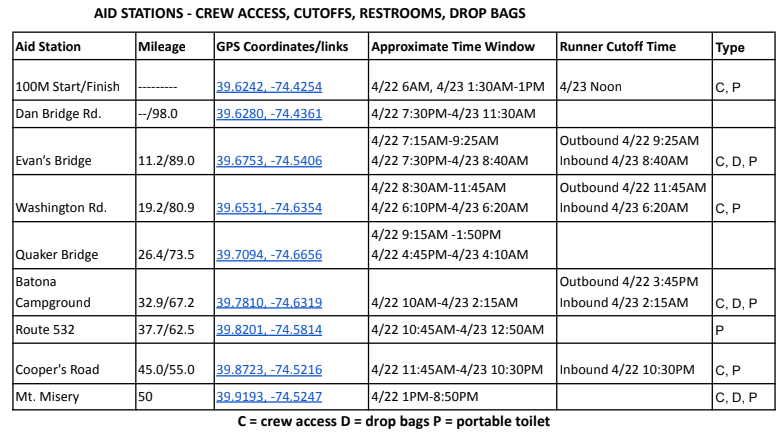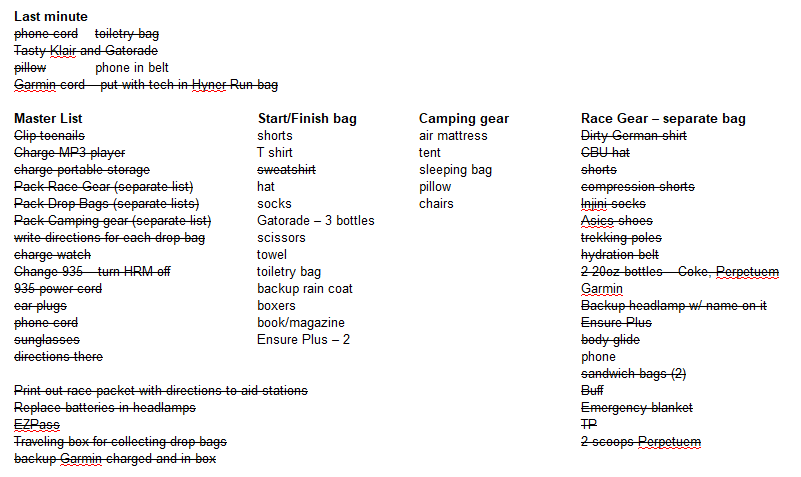I typically go through a similar process heading into each of my hundred mile races. I’m a spreadsheet guy so this is tracked in an excel file. The benefit of planning out my races in spreadsheets is that I can just copy/paste my last race’s plan and tweak as necessary.
Aid Stations
For me, everything starts with the aid stations. This is the skeleton of your race plan and the goal is to match up what you need with where you can get it.

The first thing to do is check distances between aid stations. Typically they’re 5 miles apart give or take. You’re basically just trying to determine if there are any sections that you’ll need to prepare specifically for. Next you’re looking for where you can have drop bags and which ones allow crew access.
Weather
Almost simultaneously with aid stations, I’ll check the weather forecast. This will tell you what type and how much clothes you’ll need. I’ve found that the more extreme the weather possibilities, the more backup and contingency plans you’ll need. It’s best to plan for temperature ranges 20 degrees above and below what is forecasted. Keep in mind that the temperature in the town you’re checking is likely to be much different than the “real feel” weather conditions on the top of a mountain ridge at 2am.
And somewhat adjacent to meteorological conditions – sunrise and sunset. You had better know when the sun’s coming up and going down so you can have a headlamp ready. Wherever you decide to put your primary headlamp, make sure your backup headlamp is available before that in case you’re moving slower than expected.
Drop Bags / Race Gear
Once I know the course layout and the weather, now I figure out all the stuff I will need to get from the start line to the finish line. If you think you’ll need something, it needs to be in a drop bag. Do not plan to get it from your crew. There are many times where you’ll be faster than expected or your crew will be delayed (i.e. GPS issues) causing you to miss them. As you’re starting out, you’ll overpack your drop bags. This is really unavoidable as you won’t necessarily know what you’ll need so you’ll toss anything and everything you can possible think of into your drop bags. Just make sure you stay within the size requirements laid out by the RD and try to keep them as light as possible as volunteers have to carry these around. I use large, 2.5 gallon ZipLock bags. They’re relatively cheap and keep my gear dry. Clearly mark your name, bib number, and aid station on each drop bag so they don’t get lost. I also typically put smaller things (charging cords, MP3 players) in separate smaller bags to make it easier to find things.
I would recommend writing out directions of what you want to accomplish at these aid stations and putting them in your drop bags. I can’t tell you how many times I’ve left an aid station forgetting to grab or do something. I’m even embarrassed to admit this still happens even with written out directions for myself. It does happen less than it used to so they are a benefit.
When I’m putting together my drop bags, I also create a race bag with all the clothes/gear I plan to start the race with. I’ve found having all my gear for the race in bags reduces the chances that something gets left behind.
Pacing Plan
Now that I have all my stuff ready to go, it’s time to figure out my pacing plan. If I was competitive, then here is where I would plan out how I would attack the race. Instead I’m thinking about how slow I want to start out. You should also determine your strategies for minimizing time in aid stations. I like to save as much time as possible through the first half of the race and bank aid station time for when I really need it. The two times I really need to spend extended time in aid stations are when I’m switching over from daytime to nighttime and when I have an issue that needs to be addressed. Essentially, the goal should be to spend as little time in aid stations as possible until it’s time to spend as much time in them as needed in order to continue moving forward. It’s a delicate balance and you should err on the side of spending time to fix problems than speeding through to save a couple minutes. This is definitely one of those do as I say, not as I do things though.
Crew Directions
For me, this is literal directions for my wife on how to get from one aid station to the other. This is where you tell your crew what you think you’ll need, how you’d like your aid station stop to go, and anything special to keep an eye out for. It’s best to have an actual meeting with them before the race to go through your expectations. It’s also a good idea to give them a heads up that you may not be the nicest or most understanding person 12-15 hours into a race.
Master Checklist
And finally, one list to rule them all. There’s a lot of things that need to be done prior to toeing the start line and you don’t want to realize at mile 60 that you forgot to change the batteries in your headlamp. Here’s an example of my master checklist from last year’s Eastern States:

Once you have your plan drawn up, it’s now time to double check it. And then triple check it. And then stress about what you forgot. After your race, go back and update your plan on what worked well and what you need to improve on. This makes the next race much easier to plan for as it’s just a matter of copying and pasting.
Happy planning!
